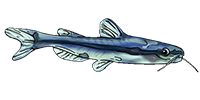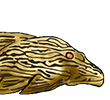eating wood
eating wood
can someone please list all the known families of loricariidae that need wood in their diets?
-
S. Allen
- Posts: 558
- Joined: 01 Jan 2003, 01:33
- Location 1: Colorado Springs, USA
- Interests: Fish: catfish, discus, stingrays. Alcohol: Vodka, Gin, Rum, Beer, Cider. Tobacco: cigars, pipe, hookah/shisha. Dogs, Literature, Music
- Contact:
panaque and I believe baryancistrus, from there I'm not sure, although seems most of the vegetarian plecos use driftwood at least as a home... possible they get some nutrition from it too.
Poking a bit of fun? http://www.penny-arcade.com/view.php3?d ... 2-16&res=l
See my fish at http://scott.aaquaria.com
See my fish at http://scott.aaquaria.com
-
Plec0maniac
- Posts: 326
- Joined: 08 Apr 2003, 10:46
- Location 1: Manila, Philippines
- Silurus
- Posts: 12475
- Joined: 31 Dec 2002, 11:35
- I've donated: $12.00!
- My articles: 55
- My images: 902
- My catfish: 1
- My cats species list: 90 (i:1, k:0)
- Spotted: 432
- Location 1: Singapore
- Location 2: Moderator Emeritus
- pturley
- Posts: 833
- Joined: 08 Jul 2003, 23:11
- I've donated: $66.00!
- My articles: 2
- My images: 16
- My cats species list: 1 (i:0, k:0)
- Spotted: 8
- Location 1: Cleveland, Ohio USA
It has always been my impression that Ancistrus species tend to fare much better if there is at least a small chunk of wood in the tank.
Given that my fish (even very shy ones) will often leave cover (caves, rockpiles, etc.) to graze on the sometimes small pieces of driftwood I add to the tanks I have to believe that they are recieving some benefit from the wood beyond simple caloric intake.
Perhaps fiber to aid in digestion? After all these are herbivourous fish with very long GI tracts.
Sincerley,
Paul E. Turley
Given that my fish (even very shy ones) will often leave cover (caves, rockpiles, etc.) to graze on the sometimes small pieces of driftwood I add to the tanks I have to believe that they are recieving some benefit from the wood beyond simple caloric intake.
Perhaps fiber to aid in digestion? After all these are herbivourous fish with very long GI tracts.
Sincerley,
Paul E. Turley
I was under the impresssion that ancistrus, panaque, hypostomus, peckoltia and cochliodon all gain lignin from bogwood ect, and use it to aid digestion. I did have a question mark against ancistrus and the other species, however i guess there is no major formal research into this. However i have always found it benifical to have wood in the tanks, however it might turn out that some are just cleaning there teeth.
- Yann
- Posts: 3617
- Joined: 30 Dec 2002, 20:56
- I've donated: $20.00!
- My articles: 8
- My images: 275
- My cats species list: 81 (i:0, k:0)
- My BLogs: 2 (i:3, p:81)
- Spotted: 109
- Location 1: Switzerland
- Location 2: Switzerland
- Interests: Catfish mainly form South America, Cichlids, Geckos, Horses WWII airplanes, Orchids
Hi!
Well the species of the following genus surely don't need wood!
Hypancistrus
Leporacanthicus
Scobinancistrus
Acanthicus
Pseudacanthicus
Regarding the other ones...the tooth shape can let us think that they are probably using these to rasp, so they possibly could occasionnaly feed on wood when needed.
Cheers
Yann
Well the species of the following genus surely don't need wood!
Hypancistrus
Leporacanthicus
Scobinancistrus
Acanthicus
Pseudacanthicus
Regarding the other ones...the tooth shape can let us think that they are probably using these to rasp, so they possibly could occasionnaly feed on wood when needed.
Cheers
Yann
Don't Give Up, Don't Ever Give Up!
- Jools
- Expert
- Posts: 16303
- Joined: 30 Dec 2002, 15:25
- My articles: 198
- My images: 946
- My catfish: 237
- My cats species list: 88 (i:235, k:2)
- My BLogs: 7 (i:10, p:167)
- My Wishlist: 23
- Spotted: 453
- Location 1: Middle Earth,
- Location 2: Scotland
- Interests: All things aquatic, Sci-Fi, photography and travel. Oh, and beer.
- Contact:
I think it is only the Loricariids with spoon shaped teeth that "eat" wood. So that would be Panaque, Panaqulous and Cochliodon. Or, to follow Armbruster, Panaque (excluding Scobinancistrus) and the most high backed Hypostomus.
I think a lot of plecos appear to "like" wood as it is in their nature to find food and shelter in and on wood in the wild. IME, in the aquarium algae often grows more quickly on wood than stone which would provide another reason why some plecos like it. Maybe it is easier to glean algae from wood than from stone?
Jools
I think a lot of plecos appear to "like" wood as it is in their nature to find food and shelter in and on wood in the wild. IME, in the aquarium algae often grows more quickly on wood than stone which would provide another reason why some plecos like it. Maybe it is easier to glean algae from wood than from stone?
Jools
Owner, AquaticRepublic.com, PlanetCatfish.com & ZebraPleco.com. Please consider donating towards this site's running costs.
- Shane
- Expert
- Posts: 4648
- Joined: 30 Dec 2002, 22:12
- My articles: 69
- My images: 162
- My catfish: 75
- My cats species list: 4 (i:75, k:0)
- My aquaria list: 4 (i:4)
- Spotted: 99
- Location 1: Tysons
- Location 2: Virginia
- Contact:
Add to this L 92 which I call "The wood -eating Lasiancistrus." These things go through driftwood like cucumber.
-Shane
-Shane
"My journey is at an end and the tale is told. The reader who has followed so faithfully and so far, they have the right to ask, what do I bring back? It can be summed up in three words. Concentrate upon Uganda."
Winston Churchill, My African Journey
Winston Churchill, My African Journey
- Jools
- Expert
- Posts: 16303
- Joined: 30 Dec 2002, 15:25
- My articles: 198
- My images: 946
- My catfish: 237
- My cats species list: 88 (i:235, k:2)
- My BLogs: 7 (i:10, p:167)
- My Wishlist: 23
- Spotted: 453
- Location 1: Middle Earth,
- Location 2: Scotland
- Interests: All things aquatic, Sci-Fi, photography and travel. Oh, and beer.
- Contact:
Wonder if those things have spoon shaped teeth?Shane wrote:Add to this L 92 which I call "The wood -eating Lasiancistrus." These things go through driftwood like cucumber.
-Shane
Jools
Owner, AquaticRepublic.com, PlanetCatfish.com & ZebraPleco.com. Please consider donating towards this site's running costs.
- kgroenhoej
- Posts: 139
- Joined: 31 Dec 2002, 11:16
- Location 1: Denmark
- Contact:
I don't think it's correct to say it's only Loricariids with spoon shaped teeth that "eat" wood - Ancistrus do eat driftwood even if there are all kinds of food all over (it's very easy to see in a bare bottom tank).
I think it's easier to say which ones doesn't eat wood - just like Yann did it.
What about Hypoptopomatinae and Loricarinae?
-Klaus
I think it's easier to say which ones doesn't eat wood - just like Yann did it.
What about Hypoptopomatinae and Loricarinae?
-Klaus
- Jools
- Expert
- Posts: 16303
- Joined: 30 Dec 2002, 15:25
- My articles: 198
- My images: 946
- My catfish: 237
- My cats species list: 88 (i:235, k:2)
- My BLogs: 7 (i:10, p:167)
- My Wishlist: 23
- Spotted: 453
- Location 1: Middle Earth,
- Location 2: Scotland
- Interests: All things aquatic, Sci-Fi, photography and travel. Oh, and beer.
- Contact:
The reason I used "eat" in quotes was that I meant to ingest wood and actually do something beneficial with it - as opposed to <I>Ancistrus</I> which I haven't observed making the same sort of inroads into my bogwood collection. I mean large <I>Scobinancistrus</i> leave marks behind on soft wood, but I'm pretty sure they aren't eating large amounts of it purposefully.
Jools
Jools
Owner, AquaticRepublic.com, PlanetCatfish.com & ZebraPleco.com. Please consider donating towards this site's running costs.
- kgroenhoej
- Posts: 139
- Joined: 31 Dec 2002, 11:16
- Location 1: Denmark
- Contact:
I think that Ancistrus is (in some degree) able to digest wood ("softwood" not "hardwood") with the help from bacterias; they may not have the same number of these "wood-eating" bacterias in their intestines as the real wood-eaters and they may not be able to life entirely of wood, but I believe they have at least some of these bacterias to help them digest softwood.
It's just my gut-feeling ( ) based on the amount of wood I can see they are eating in my tanks.
) based on the amount of wood I can see they are eating in my tanks.
Do you know otherwise?
-Klaus
It's just my gut-feeling (
Do you know otherwise?
-Klaus
- Silurus
- Posts: 12475
- Joined: 31 Dec 2002, 11:35
- I've donated: $12.00!
- My articles: 55
- My images: 902
- My catfish: 1
- My cats species list: 90 (i:1, k:0)
- Spotted: 432
- Location 1: Singapore
- Location 2: Moderator Emeritus





